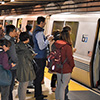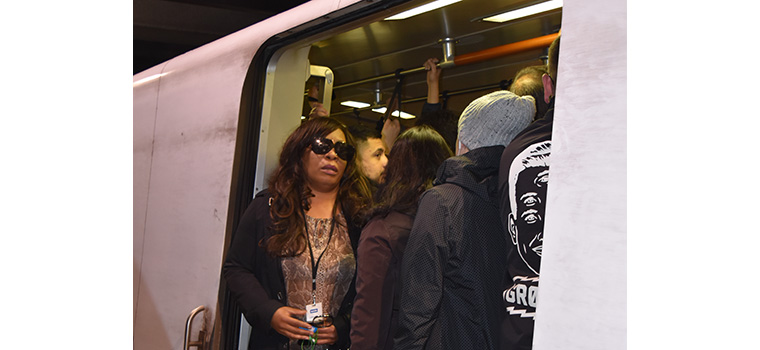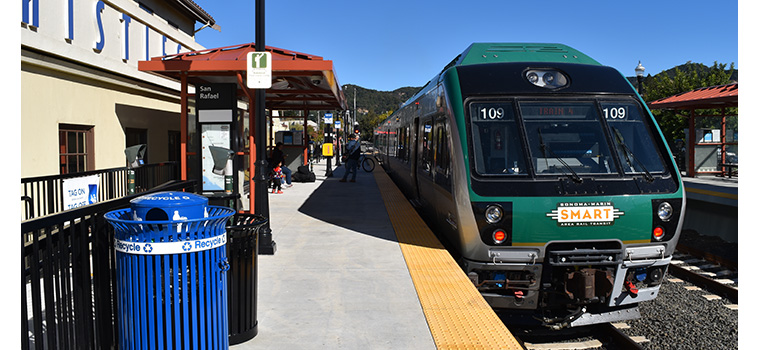Regional Measure 3 (RM3) will appear on the June 5 ballot, and a favorable outcome will raise critically needed funds for transportation improvements in the Bay Area.

Photo by Joel Williams
BY JOEL WILLIAMS
Published: April, 2018
Regional Measure 3 (RM3) will appear on the June 5 ballot, and a favorable outcome will raise critically needed funds for transportation improvements in the Bay Area. If approved by a majority of voters in Alameda, Contra Costa, Marin, Napa, San Francisco, San Mateo, Santa Clara, Solano and Sonoma counties, RM3 will finance a $4.45 billion slate of highway and transit improvements with the potential to have a transformative impact on Bay Area transit systems.
If approved, RM3 funds will come from increased bridge tolls on the seven state-run Bay Area bridges: the Antioch, Benicia-Martinez, Carquinez, Dumbarton, Richmond-San Rafael, San Mateo-Hayward and San Francisco-Oakland Bay bridges. (The Golden Gate Bridge is run independently by the Golden Gate Bridge, Highway and Transportation District.)
Last month we focused on how RM3 is our best chance to improve and expand the San Francisco Bay Ferry system. This month we will take a look at how RM3 funds would be used to expand and improve rail service in the Bay Area.
A Better BART
By far the most overburdened rail system in the Bay area is the Bay Area Rapid Transit (BART) system. That’s why a substantial amount of RM3 funds will go to improving and expanding BART service.
RM3 allocates $500 million to purchase new railcars to expand the BART vehicle fleet—this will allow for more frequent trains, less crowding and improved reliability. According to BART, the funds will help purchase an additional 300 vehicles that, coupled with other system improvements already underway, are expected to boost transbay passenger capacity by up to 30 percent.
An additional $375 million would go towards extending BART from the Berryessa/North San Jose Station (expected to open in summer 2018) to San Jose and Santa Clara. The project includes new stations in Alum Rock, downtown San Jose, San Jose Diridon Station and Santa Clara.
An additional $100 million would be used expand Diridon Station to more efficiently and effectively accommodate existing rail service, future BART and high-speed rail service, and Santa Clara Valley Transportation Authority (VTA) light rail and buses. On top of that, another $50 million would be available to fund studies, conceptual engineering, design and planning for a potential second transbay rail crossing in the Bay Bridge area to serve BART and other rail options.
More Muni
A yes vote on RM3 will also provide $140 million for Muni fleet expansion and facilities. These funds would be used to replace and expand San Francisco Municipal Railway’s vehicle fleet and associated facilities. Muni, which also includes 54 bus lines, serves 44 percent of the 1.8 million regional public transit trips taken each day.
Caltrans to Transbay
Caltrain ridership has grown over 80 percent since 2010. RM3 designates $325 million to extend Caltrain from its current San Francisco terminus at Fourth and King Streets to the Transbay Transit Center, the future hub for regional bus service and the new San Francisco terminus for Caltrain and future high-speed rail. In addition, up to $5 million in annual operational funds would be available for transportation-related costs associated with operating the new Transbay Transit Center.
A SMART Extension
RM3 designates $40 million towards completion of the extension of Sonoma-Marin Area Rail Transit District (SMART) north of the Charles M. Schulz-Sonoma County Airport to Windsor and Healdsburg. And $30 million would be used in construction of a replacement to the San Rafael (Bettini) Transit Center in downtown San Rafael that will be needed in order to facilitate the southern expansion of the rail service to Larkspur. When completed, commuters will be able to travel all the way from Healdsburg to San Francisco on public transportation via SMART and the Golden Gate Ferry.
Capitol Corridor
Another $90 million would be invested in improvements to the performance of the Capitol Corridor rail service, which operates weekday and weekend rail service from San Jose to Sacramento. The project funds are designed to reduce travel times, including between Oakland and San Jose; allow more frequent service; and improve safety and reliability.
Other Provisions
In 2017, the Core Capacity Transit Study, a joint effort conducted by five transit operators in coordination with the Metropolitan Transportation Commission and the San Francisco County Transportation Authority, identified a number of additional critical Bay Area transit improvements. RM3 will provide $140 million to implement those recommendations, which will increase transit capacity to and within San Francisco. Priority will be given to Alameda-Contra Costa Transit District (AC Transit) projects identified in the study. Projects include: new transbay buses; bus priority infrastructure, such as traffic signal priority for buses; queue bypass lanes; and bus stop relocations.
If passed, RM3 would also provide at least $1 million in annual operating expenses to establish the Independent Office of the BART Inspector General to identify opportuni-ties to improve the efficiency of BART operations and delivery of capital projects, including toll-funded projects.
Bay Crossings was founded as a newsletter in 2000 supporting the newly formed Water Transit Authority (WTA) and advocating the establishment of the government agency to expand ferry services on the Bay as a way to reduce congestion on the region’s roads. We have al-ways vigorously supported public transportation and will continue to do so. You can count on reading more about the importance of the passage of RM3 over the next two months as we approach the June 5 ballot. Please join us in getting the word out about this essential measure to expand and maintain public transportation in the Bay Area.

Passage of RM3 would mean 300 additional BART vehicles that would increase passenger capacity by up to 30 percent. Photo by Joel Williams

If RM3 succeeds, $40 million of RM3 funds will go towards extending SMART train service north to Healdsburg. Photo by Joel Williams

